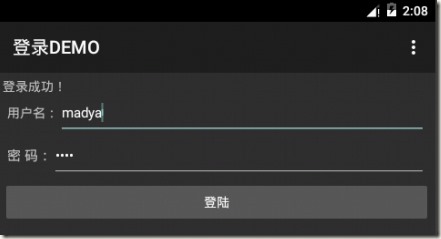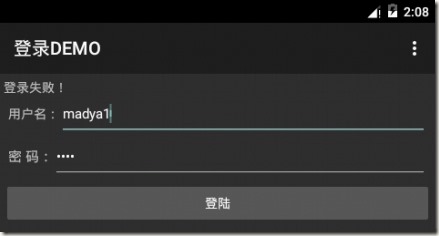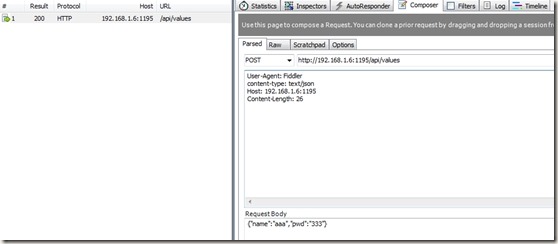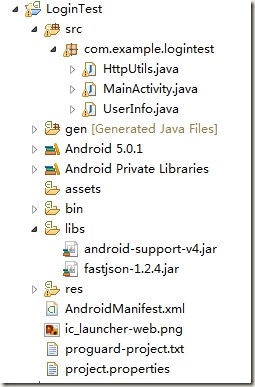.Net程序员安卓学习之路3:Post数据给网络API
本例我们实现一次真正的网络交互,将数据POST到API,然后接收服务器的返回值进行处理,同时引入自定义类型和传说中阿里的FastJson。
实现思路如:
1. 在API端接收客户POST的数据还原成对象,给每个属性加个后缀后输出;
2. 在客户端输入用户名和密码,用来和服务器端返回的进行对比;
我们POST给服务器的是name=mady&pwd=123,服务器分别加了后缀为name=madya
&pwd=1231所以我们客户端需要输入madya和1231才能验证成功。
具体操作展示如下:
一、准备API:
目前写API使用ASP.NET WEB API2再合适不过了。在VS2013中创建一个API项目,先配置他支持JSON:
打开项目中的WebApiConfig文件,在Register方法中加入一个配置项:
config.Formatters.JsonFormatter.SupportedMediaTypes.Add(new MediaTypeHeaderValue("text/html"));
创建实体类如:
public class UserInfo { public string name { get; set; } public string pwd { get; set; } }
打开ValuesController修改代码如下:
// POST api/values public UserInfo Post([FromBody]UserInfo value) { return new UserInfo { name = value.name + "a", pwd = value.pwd+"1" }; }
就可以打开Fidder调试了,直到成功为止:
二、引入阿里的FastJson包
直接右键粘贴进去即可:
这个包真心好使:
String json=JSON.toJSONString(user); //序列化 UserInfo userInfo=JSON.parseObject(json,UserInfo.class); //反序列化
就这2句话全部搞定。
我们继续,先新建一个Java的实体类:
import java.io.Serializable; public class UserInfo implements Serializable{ private String name; private String pwd; public String getPwd() { return pwd; } public void setPwd(String pwd) { this.pwd = pwd; } public String getName() { return name; } public void setName(String name) { this.name = name; } }
然后修改网络访问类,上节那个太简陋了(见附)。
然后修改异步部分代码:
protected String doInBackground(String... params) { // String citiesString ="{\"name\":\"mady\",\"pwd\":123}"; UserInfo user=new UserInfo(); user.setName("mady"); user.setPwd("123"); String str_json=JSON.toJSONString(user); return HttpUtils.sendPostMessage(params[0],str_json); }
和完成代码:
protected void onPostExecute(String result) { TextView lblInfo=(TextView)findViewById(R.id.form_title); EditText txt_login_name=(EditText)findViewById(R.id.txt_login_name); EditText txt_login_pass=(EditText)findViewById(R.id.txt_login_pwd); String loginName=txt_login_name.getText().toString().trim(); String loginPass=txt_login_pass.getText().toString().trim(); UserInfo userInfo=JSON.parseObject(result,UserInfo.class); if(loginPass.equals(userInfo.getPwd())&&loginName.equals(userInfo.getName())) { lblInfo.setText("登录成功!"); } else { lblInfo.setText("登录失败!"); } }
到此完工,没有修改的就是没有变化的。
附上新网络访问类:
public class HttpUtils { /** * @param path 请求的服务器URL地址 * @param encode 编码格式 * @return 将服务器端返回的数据转换成String */ public static String sendPostMessage(String path,String jsonStr) { String result = ""; HttpClient httpClient = new DefaultHttpClient(); try { HttpPost httpPost = new HttpPost(path); httpPost.addHeader("content-type","text/json"); httpPost.setEntity(new StringEntity(jsonStr)); HttpResponse httpResponse = httpClient.execute(httpPost); if(httpResponse.getStatusLine().getStatusCode() == HttpStatus.SC_OK) { // Log.e("Json+++++2:", jsonStr); log info for debug HttpEntity httpEntity = httpResponse.getEntity(); if(httpEntity != null) { result = EntityUtils.toString(httpEntity, "UTF-8"); } } } catch (Exception e) { e.printStackTrace(); } finally { httpClient.getConnectionManager().shutdown(); } return result; } }
分类:
Android









【推荐】国内首个AI IDE,深度理解中文开发场景,立即下载体验Trae
【推荐】编程新体验,更懂你的AI,立即体验豆包MarsCode编程助手
【推荐】抖音旗下AI助手豆包,你的智能百科全书,全免费不限次数
【推荐】轻量又高性能的 SSH 工具 IShell:AI 加持,快人一步
· go语言实现终端里的倒计时
· 如何编写易于单元测试的代码
· 10年+ .NET Coder 心语,封装的思维:从隐藏、稳定开始理解其本质意义
· .NET Core 中如何实现缓存的预热?
· 从 HTTP 原因短语缺失研究 HTTP/2 和 HTTP/3 的设计差异
· 周边上新:园子的第一款马克杯温暖上架
· 分享 3 个 .NET 开源的文件压缩处理库,助力快速实现文件压缩解压功能!
· Ollama——大语言模型本地部署的极速利器
· DeepSeek如何颠覆传统软件测试?测试工程师会被淘汰吗?
· 使用C#创建一个MCP客户端